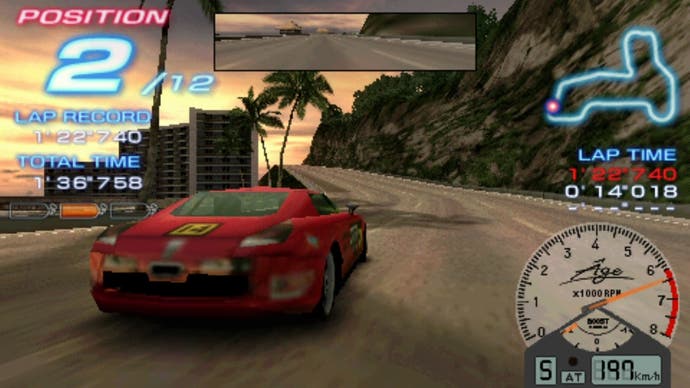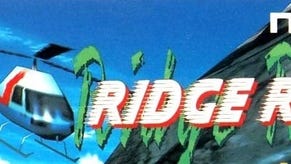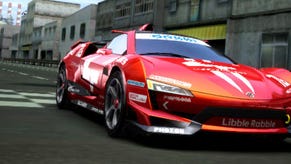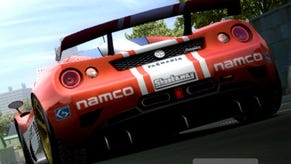20 years of PlayStation: the Ridge Racer revolution
Digital Foundry revisits the PS1 game-changer - and talks with its developer.
December 3rd, 1994 - Sony launches the original PlayStation in Japan, bringing with it seismic shift in the nature of console gaming. The 2D era of sprites and bitmap art was coming to an end, with polygon-driven 3D the new standard in state-of-the-art visuals. The Sega Saturn launched a couple of weeks ahead of Sony's debut console, but it was the PlayStation that set the standard for technological innovation in this new era. Namco's Ridge Racer launched alongside the new hardware - and it was a revelation.
"Most of the racing games were with 2D at that time and it was still difficult to give the feeling that you were really driving the car," Ridge Racer's visual director Yozo Sakagami tells us. "However this 3D Ridge Racer could provide the moment that you drift around corners with a high speed feeling and I was very happy with the fact that this new game experience was accepted by many consumers."
Perhaps 'acceptance' is an understatement. While both Nintendo and Sega had dabbled with home 3D on their previous consoles, nothing matched the Ridge Racer experience: texture-mapped objects rather than flat-shaded polygons, a fluid, consistent frame-rate, melded with brilliant playability, backed by a unique CD soundtrack a generation beyond the 8-bit chip-tunes of the Super NES and Mega Drive.
But as powerful as Sony's hardware was, bringing Ridge Racer across to the system wasn't easy. PlayStation's custom hardware was a world apart from Ridge Racer's System 22 foundation. Today's development workflow effectively sees the same programming operating on all targets, with a tiny percentage of the code dedicated to individual platforms. Consoles have become homogenised, all of them working from a common PC foundation. Back then, things were different. Ridge Racer required a complete rebuild from the ground up, but perhaps the key to its success was the fact that the conversion work was carried out by the same people who created the arcade original.
"We needed to develop the game from scratch in order to match with performance of PlayStation 1," notes Sakagami. "Ridge Racer for PlayStation 1 was actually developed by the arcade team. After Ace Combat and Final Lap R development, I joined the Ridge Racer team. We had a really friendly atmosphere within the team and always talked about how we could develop [a] better game."
The scale of the task was extensive. The arcade version runs at a much higher resolution, at double the frame-rate, with much more detail. Over and above the reduced pixel count, there's also a 'stippling' effect to the visuals unseen in the arcade game, produced by the startlingly low colour depth. But replaying the game, you realise the extent of the stunning work Namco did under the bonnet. Despite its technological limitations, there's a compelling argument that the home version plays better.
"Of course, it was not easy. Considering the hardware, we needed to develop the game from scratch. The most difficult thing was to provide the experience that you are really driving a car, since Ridge Racer [in the arcade] was a real driving experience with steering, pedal, seat and so on," Sakagami says.
"There were several colleagues who thought that these elements were important and they believed that the game controller for PlayStation 1 couldn't be the same. Hence we had the arcade version of Ridge Racer at the development studio and we played it every day in order to gather the feedbacks about both arcade and console Ridge Racer game."
The Ridge Racer experience is defined by its insane, brilliant drifting model. Without access to a steering wheel controller (something Namco would later attempt to address with the JogCon), the developers had to adapt. Perhaps it's the limitations of emulation, but the arcade Ridge Racer doesn't drift like the home version at all. It feels much safer, easier - less dangerous. This fundamental component would be revised across later Ridge Racer titles - drifting effectively in the original PlayStation release is brutally hard - but the work began here in 1994 and it's surprising how well it still holds up 20 years later.
The fact that Ridge Racer plays so well, and compares so favourably with the arcade version as a gameplay experience is all the more remarkable bearing in mind a key compromise Namco was forced to make, dropping the arcade's flawless 60Hz update down to 30fps - a compromise that is part and parcel of the home console experience nowadays. The change didn't really register with press or enthusiasts at the time - bearing in mind the 3D standard at home was much lower, even in titles accelerated by Nintendo's SuperFX chip, or Sega's Virtua Processor. 30fps provided a consistent fluidity to 3D gameplay that had never been seen on a console title before.
"Considering the fact that this was our first development for PlayStation and the development period was only six months, we could not take a risk and decided to have a locked 30fps," Sakagami says - but the full 60fps experience was never far from the thoughts of the Ridge Racer team.
"Ridge Racer with 60fps was included into R4-Ridge Racer Type 4, as Ridge Racer Hi-Spec version. It was actually what we wanted to do for first Ridge Racer on PlayStation 1 and I was very happy that we could do it with the R4 release."
But despite the many compromises, Ridge Racer looked and played like nothing else at the time. There must have been a point during development where the game started to come together, where the team must surely have realised that it was developing something special, something genuinely game-changing.
"It was the moment when we first saw the game play on an actual TV screen. We didn't finalise the UI and detail at that time but we all realised that this game would be very interesting," Sakagami replies with some degree of modesty.
Ridge Racer may not have been 'arcade perfect' - to use the parlance of the time - but it was a hugely significant release. As developers struggled with the transition from sprites to texture maps, Namco leveraged its existing experience with arcade 3D technology to create the most polished, technically adept polygon-driven console game of the time. It followed in the wake of a Sega Saturn conversion of Virtua Fighter that felt a little rough around the edges. Four months later, the Saturn version of Daytona USA would impress with its raw playability, but visually the game still couldn't meet the polish, quality and sheer performance of Ridge Racer. It took some time for the competition to catch up, but by the time Sega Rally appeared, PlayStation's dominance of the home console market was starting to take hold. Indeed, the level of its success would have dramatic consequences for the arcade market too.
"At that time, what arcade games tried to achieve was to provide a real experience to the game. For the arcade version of Ridge Racer, the arcade cabinet included steering, pedal, gear stick and the seat, which was even used for a real car," Sakagami says, Namco's thinking being that home and arcade could co-exist by offering different experiences.

The gorgeous playability that the team tried so hard to bring to PlayStation was taken care of to a certain extent through the feedback and steering wheel interface offered by the high-end cabinet, but these outrageous constructions, not to mention the rendering hardware itself, were immensely expensive. Sony's PlayStation technology offered up a more less sophisticated but more cost-effective alternative - the lines that separated the home console and the arcade experience were beginning to blur.
"I am not really sure about detail but at that time Bandai Namco had already developed System 22, which was powerful in terms of 3D graphics and texture-mapping," Sakagami recalls. "Bandai Namco was also trying to develop the 3D system with low cost for console games at that time. Then, we heard the concept of PlayStation from Mr. Kutaragi and decided to work together."
The rest, as they say, is history. System 11 was the PlayStation in all but name, with minor enhancements to suit arcade development - such as an increase in available graphic RAM.
"The first arcade Tekken was developed on System 11, and could be converted to PlayStation 1 right after the arcade version. This was very successful way at that time to connect both arcade and console markets."
By the time PlayStation 2 had established itself, the arcade's place as the home of cutting-edge technological innovation was almost over. But Ridge Racer evolved with the times, transitioning from an ultra-deluxe, cutting-edge arcade game into a franchise title that demanded attention at each major console launch. Right up until the launch of PlayStation 3 in late 2006, Ridge Racer provided unique arcade thrills, back by solid, impressive technology. Ridge Racer 7 was the first - and one of the only - titles to run at full 1080p resolution at 60fps.
Now, it feels as though the series lies dormant. Both the Vita version and its 3DS stablemate lacked the magic and both saw a downgrade to 30fps, while the latest Ridge games have been mobile games - a logical progression in some ways, but not quite the final fate we envisaged for a revered franchise. Some might say that the series had run its course on the home consoles, but in our view there's always a place for a new Ridge Racer with the arrival of next-gen hardware.
Last year, Ryse and Killzone Shadow Fall impressed with stunning visuals while Battlefield 4 redefined console multiplayer, but it was the retro-inspired Resogun that won the hearts of the hardcore gamers. Its combination of beautiful imagery, 1080p60 gameplay and an old school arcade experience proves that the formula can still work. Our interview sadly lacks a response to the question of whether the series will return to home console hardware, but there'll always be a place in our heart - and indeed our software collection - for a new Ridge Racer.

















